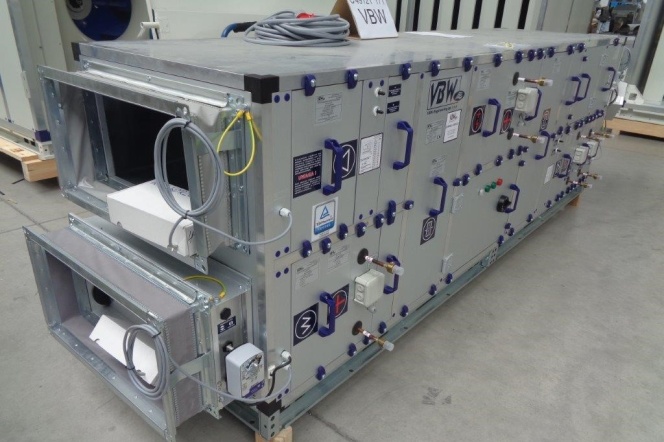Date added: 2021-09-13
Simultaneous production of electrical energy of heat and cold? We have not had it before in Poland

The system is an effect of a project within the Action 4.1.2 – Regional Research and Development agendas of the Operational Program Intelligent Development: : POIR.04.01.02-00-0018/17-00 between GUT, Faculty of Mechanical Engineering and Ship Technology, Institute of Energy and VBW sp. z o.o. company.
The project entitled INNOECOTRIBLOCK „Innowacyjne urządzenie trigeneracyjne do produkcji energii elektrycznej i chłodu dla energetyki rozproszonej o obniżonej emisji środowiskowej” (Innovative tri-generation device for production of electrical energy and cold for dispersed energy production with lowered environmental emmissions) was supervised and managed by professor Dariusz Mikielewicz PhD, DSc, ME, of the Institute of Energy, vice-rector for development and organization.
Device developed within the project utilizes a device for heat-moisture processing integrated with a reversive air heat pump. - The pump is powered by a multi-fuel motor - says professor Mikielewicz - Reversive air heat pumps are perceived to be perspective heat sources and belong to a group of equipment qualified for the renewable energy sources. It is an innovative concept, there is no analogue in the national market.
Co-operation between a heat pump and a combustion engine will counter the drawbacks?
– One of the drawbacks of heat pumps consists in their decreasing coefficient of heating efficiency in the conditions of increasing difference between the temperature of the upper and lower heat source, which practically disqualifies these devices from operation in winter conditions. In such a situation, the operational economy of the device becomes less profitable. Using a combustion motor to power such a pump, using at the same time the heat of the motor cooling system and exhaust for increasing the technical parameters of the air at the pump inlet and for preparation of hot water – allows a whole year long operation of the system – indicated professor Mikielewicz.
Cold produced in summer
A feature that distingushes the proposed solution is the application of a multi-fuel motor to produce electrical energy and heat and using these energy media for powering an air heat pump and, also, device for heat-moisture processing. - Application of the motor cooling and exhaust heat will eliminate the stoppage in the operation of the heat pump necessary to defrost the device and, at the same time will decisively improve the operational properties. Excess heat, with possible addition of the recuperation of heat from the exhaust can be used for preparation of domestic hot water. – says the project manager.
What is more, in the summer the device will produce cold in cooperation with a hybrid adsorption air-conditioning device lowering the demand for cold and increasing the energy efficiency of the heat pump. Proposed solution is a tri-generation device ensuring the optimum usage of primary energy in fuel annually. Electrical current produced by the system can be used in other ways, depending on the operational priority.
No more high losses?
The developed trigeneration technology is all the more important that in Poland professional production and distribution of electrical energy is burdened with high losses (mean operational efficiency of an electrical power and heating plant is approximately 36%). Polish distribution network can deliver electrical energy of appropriate voltage if a medium voltage line is no longer than 50 km, and low-voltage line is no longer than 500m. Meanwhile, in rural areas over 12% of low-voltage power lines exceeds 1000m in length and 44,8% exceeds 500m. In case of medium voltage lines 18% is longer than 50 km. In a situation where the energy companies investments are focused on the maintenance of the infrastructure and its limited expansion, such a state of the matter forces investments into dispersed energy production, proposed in the developed prototype as a microsource. Such approach is compliant with the national plan of building a low-emission economy and worldwide trends.
Summing up, the most important features of the developed system include:
– Using air as a lower source of heat while maintaining full efficiency of the device within a wide range of temperatures - in order to lower the investment costs for a potential user.
– Using exhaust energy from the motor in winter to support the operation of air heat pump and in summer to lower the demand for cold and to increase the energy efficiency of the heat pump.
– Application of the heat recuperation to increase the efficiency of using primary energy and to increase the temperature range of the lower heat source in which the pump will operate efficiently.
– Ensuring the compatibility of the new heat pump with existing and operational solutions available in the market (particularly with ventilation/air-conditioning centers featuring adsorption module).
– Using an adsorber to change the heat-moisture paremeters of the air at the inlet to the cooler/evaporator (in summer conditions) in order to lower the demand for cold or maintain the level of moisture of the blown in air in comfort conditions.
Device developed by the team of the employees of the Institute of Energy of the Faculty of Mechanical Engineering and Ship Technology in cooperation with VBW Engineering company perfectly fits into the range of mass launching of air heat pumps which in national conditions meet the barrier connected with their very low efficiency in winter conditions. Proposed device allows initial preparation of the air for the air heat pump in such a way that very attractive coefficients of heating efficiency can be achieved. Additionally the compressor motor can be powered with electrical enegry produced by a low-emmission combustion motor powered by fuels originating from the processed biomass.
It is anticipated that the solution shall enjoy a high interest. It positively influences the limiting of industrial losses and decreasie of the negative effect of systems providing thermal comfort on the environment.



